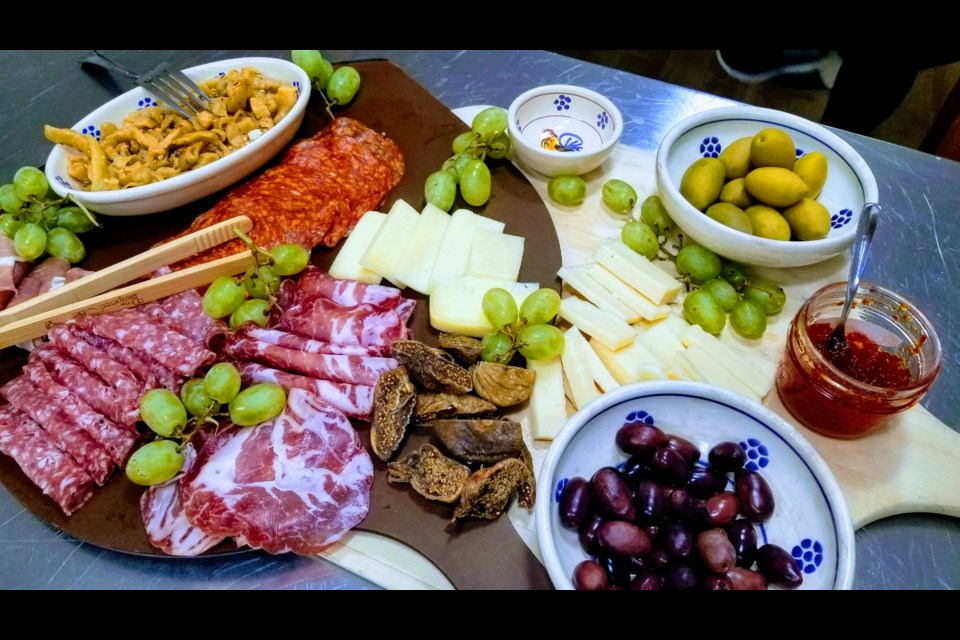Charcuterie is the French term for cured meats or, in Italian, salumi (plural form of salami). Growing up in a southern Italian family I am quite familiar with Italian salumi as my family has made different varieties in their homes for generations.
While my classmates pulled bologna sandwiches on white sliced bread out of their lunch boxes in primary school, myself and my five siblings had homemade Calabrese, soppressata salami on a kaiser roll. At the time, I remember feeling quite self conscious as there were only a handful of Italian-Canadian children at our primary school and I would have done anything to have the same sandwich as my non-Italian friends. Fast forward to many years later and I still have never eaten a bologna sandwich on white sliced bread.
The charcuterie my family made were very much traditional recipes that have been around for centuries. They brought these recipes with them to Canada when they immigrated from Calabria, a region in the south of Italy known for its pork and salumi.
In the winter months, when the perfect temperature had been reached, my extended family would gather in one home to make soppressata salami, capicola, pancetta, cacciatore and/or prosciutto. They would often make fresh sausages as well. The cacciatore, or cured sausages, would be ready to eat way sooner than the other salumi as they were much thinner and cured more quickly. This made waiting for months for the larger salumi to cure a little easier as we could enjoy the cacciatore in the meantime.
My family made salumi the natural, traditional Calabrese way with only pork, natural casings, spices, wine and salt for curing. They did not use nitrates. It was a precarious exercise as it would sometimes spoil if the temperature, techniques or the ingredients were not just right (not something I would recommend for the amateur).
Many of the Italian, homemade salumi we prepared at home can now be bought commercially, unlike when many Italians first immigrated to Canada. The classics are still the most popular; prosciutto crudo (cured), prosciutto cotto (baked), capicola, soppressata salami (Calabrese), mortadella and genoa salami (Liguria).
Today the list has grown to include coppa, lanza, bresaola, speck, guanciale, nduja and so much more. Some, such as guanciale and nduja, are still somewhat new to the North American market as they were not imported here until more recently Nduja is a spreadable salami product that originates from Spilinga, Calabria. It has a somewhat fascinating history that goes back to the Normans in Calabria. Guanciale is similar to bacon or pancetta but it hails from the pork jowl or cheeks.
With all these varieties to choose from it’s obvious one could make a sandwich with them or use them in a recipe but the art of the antipasto, or assorted Italian appetizer, has recently exploded in popularity in the form of a charcuterie board. This is a fabulous way to enjoy a number of these fabulous salumi along with assorted cheese and other accompaniments.
Charcuterie boards had gained popularity on the food scene some time ago and the pandemic has only further entrenched this snack, appetizer or light meal into the homes of many North Americans. Why? Mostly because it is an easily transportable takeout item for restaurants and secondly it makes economic sense for the consumer to just buy small portions of a number of items rather than full-size products. Also, with so many meals being consumed outdoors during the pandemic, it's perfect picnic fare.
Here is what you need to make your own:
- Choose a beautiful wood board or platter for serving
- Have the charcuterie freshly sliced right before preparing your board, mix mild and spicy selections and different textures (three to four varieties in all)
- Choose one or two types of cheese, different textures, cut into small portions
- Choose a sweet accompaniment like a fruit compote or honey
- Add one or two types of nuts
- Add some dried fruit
- Add at least one type of olive or pickled vegetable
- Add a spicy accompaniment like a chili paste
- Add two starches such as crostini and crackers
Starting with tiny bowls full of the spreads, olives and nuts, add them to the board spacing them out. Fill in the spaces between by folding, rolling or placing the sliced charcuterie. Then fill in with the cheese pieces. Keep in mind that alternating colors and textures while overlapping the items is most pleasing to the eye. Continue to fill the voids with the dried fruit, crostini and crackers. Occasionally step back and look at the entire board as a composition.
Remember you eat with your eyes first.
Depending on how many you are serving and whether it is a snack, appetizer or light meal, judge the appropriate quantities. Best to add more if needed rather than have too much and have it dry out and be wasted.
Locally
If your own family does not make homemade charcuterie, a local family-run business has you covered. Italia Salami has been making Italian Salumi for over 50 years in its local factory with its original recipes. This family run establishment is Guelph’s best kept secret. Not only can you get authentic soppressata, prosciutto, capicollo, pancetta, coppa and mortadella but their factory outlet has everything you need to make your charcuterie board as well. Imported cheeses, olives, spreads, anchovies, tarelli, compotes and more.
So whether you purchase an already made charcuterie board or make your own you can enjoy this food trend anywhere,anytime. Just add a bottle of your favourite wine. What more could you ask for?


